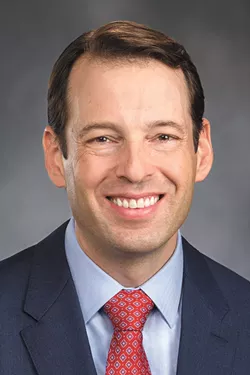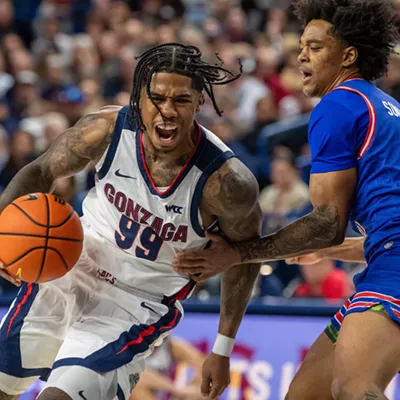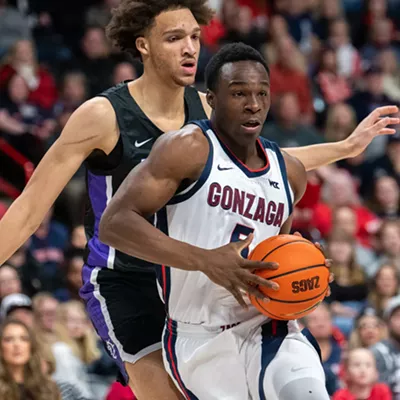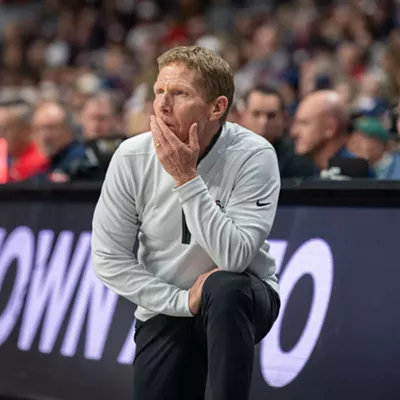
Hundreds of unblinking, oversized, crimson-clad figures gaze down silently upon Martin Stadium in Pullman last November. Cardboard cutouts of celebrities, dogs and smiling alumni of all ages are packed into a couple small sections of the otherwise deserted football stands. Referees pull down their masks so they can blow their whistles between downs. Canned crowd noise hisses in the background, rising and falling in a surreal echo of another time.
Despite extraordinary efforts to keep competing amid the COVID-19 pandemic, the Nov. 14 loss to Oregon marked Washington State University's only home football game of the four-game season.
Just two days earlier, WSU's governing Board of Regents met on Zoom to discuss whether the university can afford football in the long run. Close to a decade of deficit spending on athletics has racked up approximately $100 million in accumulated debt and triggered widespread budget crackdowns across academic programs.
University administrators say they expect WSU Athletics to overspend at least another $22 million this year due to lost ticket sales and other shortfalls.
"Can you be in the Pac-12, but not have football?" one regent asks. "Can you throw fencing in there and say we have [enough] sports?"
The short answer is no. The long answer involves an arms race to recruit winning players and lure coaches with multimillion-dollar salaries, large spending gambles on new facilities, an evolving sports media landscape and the long-simmering tension between WSU's culture of athletics and its core mission of higher education.
WSU President Kirk Schulz and other administrators argue that a competitive athletics program brings outsized returns in national recognition, student recruitment and intercollegiate partnerships. Many consider sports an essential part of the on-campus experience. It helps leverage donors.
"While I am an avid college football fan, I am certain students are more concerned with the return on investment for their tuition dollar."
Faculty say athletics spending has siphoned funding and financial flexibility away from investments in teaching and research in recent years, sparking resentment over pay disparities and accountability. They have voiced strong opposition to a new proposal to redirect university funding to subsidize athletics indefinitely. Students have also raised concerns about aging facilities, reduced class offerings and limited support services.
"I firmly believe this athletics spending represents an imbalance of priorities," student government President Curtis Cohen wrote recently. "While I am an avid college football fan, I am certain students are more concerned with the return on investment for their tuition dollar."
WSU first joined what is now the Pac-12 Conference in 1917. The Pac-12 — one of the five largest conferences overseeing intercollegiate athletic competition — controls game schedules, media rights, revenue distribution and other operational standards. Due in part to its remote location, WSU has long struggled to keep up with the facilities and recruiting resources of the other West Coast universities in the conference.
While WSU teams have sometimes outperformed expectations with runs to football bowl games, Klay Thompson-era basketball or the women's soccer streak to the Final Four in 2019, the university also has a reputation for snatching defeat from the jaws of victory. Even the most promising of teams have a tendency to "Coug it."
Starting in 2010, former WSU Athletics Director Bill Moos worked to remake the football program with new facilities and the 2011 hire of Head Football Coach Mike Leach. Expecting a windfall of new money from Pac-12 media revenue, Moos and others pitched a $65 million renovation of the stadium to add premium suites and a new $61 million football complex — complete with underwater treadmills and luxurious players' lounges.
Stacy Pearson, WSU's vice president of finance and administration, says the Pac-12 media deal never paid off as planned, leaving the university covering top-tier salaries and about $10 million a year in debt payments on the new facilities. As the program went over budget year after year, athletics drew from the university's reserve funds.
"Many commitments were made betting the [Pac-12 media] revenues would come," she told regents in November. "Those revenues didn't really materialize."
Under the late WSU President Elson Floyd, the regents also approved the launch of the Spokane medical school, a $12.5 million golf course and clubhouse project, and other major expenditures. When Schulz took over in 2016, he immediately cited athletics and other deficit spending as serious concerns, but the debt continued piling up.
The university spent down more than half its central reserves — a drop of $115 million — in five years, financial reports state. And while athletics has an annual budget equal to just 7 percent of the university's overall budget, athletics spending made up 58 percent (about $67 million) of the hit to reserves.
By 2017, Schulz told Moos he needed to consider making some visible budget cuts to show legislators they were taking the deficit seriously. Pearson started sounding the alarm, calling the athletics spending a "very serious financial situation." Athletics staff email responses argued that making significant cuts to spending would be "devastating."
"The entire University has to work to reduce this deficit," Pearson emailed Moos, "and it can't be done if Athletics continues to spend millions into deficit each year."
Within months, Moos took a new job at the University of Nebraska with a base salary of $1 million a year.

WSU faculty and staff across a broad variety of departments say they have endured several years of austerity during this period of athletics growth. In public comments, employees say they have seen class sizes go up and duty loads increase as vacant jobs remain unfilled to save money. Laboratories and research equipment have deteriorated. Some complained on a faculty blog of working in buildings with contaminated water systems or unreliable power.
In late 2017, Schulz announced 2.5 percent budget cuts university-wide as part of a multiyear effort to slow the spending down of reserves. The plan froze most hiring and eliminated the performing arts program, which brought a diverse lineup of musical and cultural events to Pullman each year.
Many universities see friction between academics and athletics as professors argue that sports represent a largely commercial endeavor that can undermine an institution's core mission to educate young minds. Sports pulls time and resources from teaching and research. They pull students out of class to travel for competition. Large events can disrupt campus life and work. It perpetuates party culture.
Some faculty members increasingly argue that high-impact sports like football pose long-term mental and physical risks they can no longer morally support, noting how WSU quarterback Tyler Hilinski, who died of suicide in 2018, was posthumously diagnosed with chronic traumatic encephalopathy.
"The body of scientific evidence is ... now quite clear that CTE leads to lifelong brain damage and cognitive disabilities," WSU physiology Professor Glen Duncan wrote to other faculty. "These deleterious consequences run counter to the mission of higher education."
The repeated renewal of the football coach's nearly $4 million annual contract — and Leach's tendency to make crass or controversial statements — also contributed to faculty resentment as most WSU employees received minimal cost of living raises. Faculty also argue that calling Pullman-centric sports "essential" to the student experience devalues the contributions of branch campus programs while still shouldering them with the debt.
Amid the financial upheaval of COVID-19, Schulz has mandated new 10 percent budget cuts to many departments while introducing another plan to keep athletics fiscally afloat. The proposal includes $7.9 million in cuts this year with $1 million to $2 million to be made permanent. But the plan also includes redirecting up to $3 million a year from university funds to further subsidize athletics in the long term.
Von Walden, a professor of civil and environmental engineering, recently chaired the faculty committee tasked with responding to the latest proposed athletics budget. He says he heard from administrative staff and grad students alike that they had made heartbreaking cuts to keep their budgets in line while athletics seemingly spent out of control.
"We had to balance our budget this year, and in order to do that my department took a 12.5 percent cut ... and we're expecting similar cuts for next year," Walden says. "I think it's reasonable to expect the athletic department to even out their book."
WSU's Faculty Senate, which provides oversight of academic standards and advocates for faculty interests, voted 48-3 against the athletics plan last month with about 240 faculty members signing a statement called the proposal "alarming." The letter is expected to go before the Board of Regents next week.
"The effects of these budget cuts to academic departments across WSU are large and painful," the letter states. "They have significantly decreased faculty's ability to perform our core mission. ... We are concerned that the proposed diversion of funds will negatively impact employee morale and the infrastructure faculty rely upon."
"I don't think there's anything more important to Washington State and to our alums than our affiliation with the Pac-12 conference."
Rodney Fort, a sports economist who spent 23 years at WSU before going to the University of Michigan in 2007, says nine out of 10 college athletic programs lose money because administrators want them to be bigger than the level of revenue they generate. Those administrators argue that spending extra money on athletics increases national visibility, alumni connections and student recruitment. Meanwhile, those who see public spending on sports as "illegitimate" will always wish universities spent less money on athletics.
"Football does not cover its own bills, and it never has," he said. "All universities are investing money into their athletics programs. ... The question is does it generate enough of this other kind of value?"
President Schulz, along with Athletics Director Pat Chun and others, has argued that WSU's affiliation with the Pac-12 and its football programs drives many universitywide benefits. They say the shouts of "Go Cougs!" they hear when traveling show the broad recognition of the university's athletics program and its essential place at WSU.
"I don't think there's anything more important to Washington State and to our alums than our affiliation with the Pac-12 conference," Chun said in 2019.
Trying to stay competitive with conference peers like Oregon or the University of Southern California has proven expensive. The university used to provide more direct financial support but started reducing those payments under Floyd to invest in other projects. Administrators argue that the Athletics Department has since decreased how much it overspends its budget in recent years, but much of that has come from aggressive fundraising — not cuts to spending.
In fiscal year 2015, the Athletics Department's debt totaled about $38 million, growing by about $10 million a year to $68 million in 2018. Initial budgets projected the accumulated deficit would peak at $85 million before Athletics would start paying back its debt.
By 2019, WSU projected the debt would peak at $103 million, then Athletics would start paying it back. Now, the accumulated debt has risen to nearly $120 million.
(During this period, regents continued approving new sports facilities like a $10 million baseball clubhouse and a $3 million renovation of the soccer field. The football team also went to the Alamo Bowl with an unprecedented 11-2 record in 2018. Athletics also hired basketball Head Coach Kyle Smith on a $1.4 million contract in 2019, buying out the previous coach's expensive contract, and hired football Head Coach Nick Rolovich this year on a $3 million annual contract.)
In recent years, WSU administrators have repeatedly overestimated the money they could raise — counting on large, sustained increases in donations, higher ticket sales and other new revenue streams. Some of those revenues have gone up, though more slowly than spending. A number of attempts to tap new funding also fell through.
Student pushback killed two attempts to impose a mandatory sports fee and the state Liquor & Cannabis Board scuttled a plan to sell alcohol at sports events. The university has also failed to strike a deal on naming rights for sports facilities.
As the university started missing its financial recovery targets, state lawmakers began focusing more attention on the issue. In 2018, Senate Majority Leader Andy Billig, D-Spokane, sponsored Senate Bill 6493, which required regents or university trustees to approve any major changes in athletics spending.
Billig, a part owner of the Spokane Indians baseball team, says many lawmakers wanted to see more transparency on college sports spending and stronger accountability to the university governing boards. The bill passed 46-1 in the Senate and 95-3 in the House.
"There is definitely increased transparency, which is good," he said recently. "Whether the accountability to trustees and regents results in more responsible spending is still an open question."
Under pressure from legislators and facing steep losses from COVID-19, administrators have scrambled to form another new plan. The university has balanced its budget each year by covering the athletics debt internally with profits from housing, dining, parking and other money-making operations. But the pandemic hit those departments hard too, leaving residence halls and parking lots mostly empty this year.
Regents and faculty have asked about leaving the Pac-12 for a smaller conference like the Mountain West. Pearson argues that the athletics facility debt and salary contracts are a fixed cost that would not go away, and switching conferences would mean a big loss of revenue. While WSU struggles to afford staying in the Pac-12, they can't really afford to leave either — at least without having a long-term plan for downsizing expenses.
Discussions took on a tinge of panic in September when local COVID-19 cases peaked and all sports competition sat idled. Regent Marty Dickinson described athletics as an "elephant that is sitting on the financials," noting the rest of the university was largely operating within its budget. She pushed for an urgent response.
"We'll bring forward some ideas," Schulz promised the regents. "Some may not be super popular internally, but ... [if] being a member of the Pac-12 is important that's going to be the steps that we're going to need to be able to take."
Regents have since reaffirmed their support of staying in the Pac-12, but faculty have continued to decry the perceived double standard where academics toes the line and athletics gets to pile up debt. Walden and other professors say they can't help but wonder what that $120 million could have done for teaching or research. The new plan to redirect more university funding to sports adds insult to injury.
"I'm contending that this is just the beginning of this request," he argues. "How else are you going to fill this hole and where's this money going to come from in the future?"
Students, their education upended by the pandemic, have also voiced concern about the disproportionate belt-tightening on academics compared to athletics. Cohen, the student government president, wrote that the administration had not justified the "embarrassingly high" level of athletics debt.
"I have so far noticed the majority of students are not pleased with this proposal," he wrote, "especially when many of our academic departments were forced to make a 10% budget cut, leading to furloughs of critical teacher assistant positions."
Faculty briefly raised the possibility of a no-confidence vote in December. They say administrators failed to provide data that justifies the new proposal. Schulz has often spoken candidly about the athletics budget, but also has repeatedly argued that much of the debt was in place before his 2016 hiring. This was, he says, the hand he was dealt.
Walden contends Schulz and other administrators signed up for these challenges.
"You took the job," Walden says. "You're in charge now. ... This has been allowed to continue under the current administration."
"I'm contending that this is just the beginning of this request. How else are you going to fill this hole and where's this money going to come from in the future?"
Beyond the impacts to WSU, university officials have cited the economic benefits that athletics brings to the broader Pullman community. The city recently reported that it saw a 24 percent drop in sales tax money in November compared with the previous November, which saw two home football games. Other pandemic restrictions certainly factored into that drop, but football traffic remains a significant market for local businesses.
SIMILAR STORY AT EWU
Eastern Washington University has likewise suffered extensive funding losses this year, with its athletics program expected to run more than $1.5 million over budget due to the pandemic eliminating ticket sales and other revenue.
Financial records show the university typically provides about $13 million in direct funding and student fees to the athletics program. Some faculty have questioned those subsidies amid budget cuts in recent years, preparing a 38-page report last year on the impacts and alternative funding models.
Head Football Coach Aaron Best missed the team’s first game of the delayed season on Saturday after testing positive for COVID-19 last week. (JACOB JONES)
Andrew Zimbalist, a sports economist at Smith College, visited the campus in 2019 for a lecture series and argued that the small-town setting likely limits how much money WSU would ever be able to raise from ticket sales or corporate sponsorship. With a smaller, isolated program, they will probably always be at a disadvantage. Potential changes to media distribution and player compensations in the years to come could also cut into revenue.
"It's really hard, and you're not as successful because of structural reasons," he said at the time. "I don't think it's going to go away. I think it's going to get worse."
Regents will have to approve any new changes to the athletics budget — if not next week, then sometime by summer. Schulz and administrators have emphasized the budget remains in flux as they navigate the pandemic and await legislative funding. Schulz wrote a letter back to faculty last week in response to their statement.
"There is still a great deal of uncertainty with the WSU budget (including our athletics budget)," he wrote. "While I understand that faculty will be upset that I am not withdrawing our proposal — I think it is far worse to withdraw the proposal now and next year bring it back up again at the last minute."
Walden, who fears the legislative session could squeeze academic funding as well, maintains that the colliding financial crises in athletics is an opportunity to cut some losses — or at least right-size the program so it can live within its means.
"We're not opposed to intercollegiate athletics," he said. "What we want is a self-sustaining athletics program. We want an athletics program that WSU can afford." ♦










